JUNE KEY FIGURES
 |  | Jun '06 | May '06 to Jun '06 | Jun '05 to Jun '06 |  |
 |  | '000 | % change | % change |  |
|  |
| Short-term visitor arrivals |  |  |  |  |
 | Trend | 456.0 | -0.6 | -0.2 |  |
 | Seasonally adjusted | 460.0 | 3.1 | . . |  |
 | Original | 382.5 | . . | . . |  |
| Short-term resident departures |  |  |  |  |
 | Trend(a) | 415.2 | 1.5 | 4.5 |  |
 | Seasonally adjusted | 434.9 | 7.2 | . . |  |
 | Original | 484.1 | . . | . . |  |
|  |
| . . not applicable |
| (a) Break in trend series from October 2005. |
Visitor arrivals, Short-term
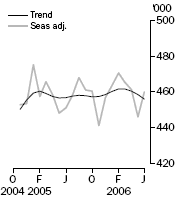
| Resident departures, Short-term
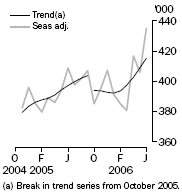
|
JUNE KEY POINTS
TREND ESTIMATES
- Trend estimates for short-term visitor arrivals to Australia during June 2006 (456,000 movements) decreased by 0.6% compared with May 2006. This followed monthly decreases of 0.3% for April 2006 and 0.4% for May 2006.
- Currently, short-term visitor arrivals are 1.3% lower than when the series last peaked in March 2006 (461,700 movements) and 0.2% lower than in June 2005.
- During June 2006, short-term resident departures (415,200 movements) increased by 1.5% compared with May 2006. This followed monthly increases of 1.4% for April 2006 and 1.6% for May 2006.
- The short-term resident departures trend series is now experiencing consistent growth, following a period of relative stability after the trend break in October 2005.
SEASONALLY ADJUSTED ESTIMATES
- Seasonally adjusted estimates for short-term visitor arrivals during June 2006 (460,000 movements) increased by 3.1% compared with May 2006 and followed monthly decreases of 0.9% for April 2006 and 3.3% for May 2006.
- Short-term resident departures for June 2006 (434,900 movements) increased by 7.2% compared with May 2006 and followed a monthly increase of 9.4% for April 2006 and a monthly decrease of 2.6% for May 2006.
ORIGINAL ESTIMATES
- In original movement terms, there were 382,500 short-term visitor arrivals to Australia and 484,100 short-term resident departures from Australia during June 2006.
NOTES
FORTHCOMING ISSUES
| ISSUE | Release Date |
| July 2006 | 4 September 2006 |
| August 2006 | 5 October 2006 |
| September 2006 | 6 November 2006 |
| October 2006 | 5 December 2006 |
| November 2006 | 11 January 2007 |
| December 2006 | 6 February 2007 |
EARLY ESTIMATES
Early estimates of short-term visitor arrivals for July 2006 will be available on the Australian Bureau of Statistics (ABS) web site on 17 August 2006. These estimates can be accessed by going to the ABS web site at <https://www.abs.gov.au>. Select All statistics - Access to all ABS products & statistics, then By Catalogue Number, then 3. Demography, then 34. Migration. Choose Short-term Visitor Arrival Estimates, Australia (cat. no. 3401.0.55.001).
DATA NOTES
This publication contains movement data. Care should be taken when interpreting this movement data as 'people'. See paragraph 5 of the Explanatory Notes for more detail.
The statistics in this publication have been rounded to the nearest 100 for short-term movements and to the nearest 10 for permanent and long-term movements. As a result, sums of the components may not add exactly to totals. Analysis featured in the Key Points and Main Features of this publication is based on unrounded data. Calculations made on rounded data may differ to those published.
REVISIONS
In June 2006 the Department of Immigration and Multicultural Affairs (DIMA) advised that some passenger cards predominantly from Adelaide airport were not processed in time for the October 2005 Overseas Arrivals and Departures data cut off date. The October 2005 data has been reprocessed to include the missing records (approximately 7,800) and revised data has been published in this issue. All associated time series spreadsheets and data files have been revised.
Differences between the revised October 2005 data and the figures published in the October 2005 issue of this publication were spread across all categories of movement and all variables. For a breakdown of the numeric differences by category of movement, see October 2005 processing in Data Quality Issues (Appendix) under the Explanatory Notes Tab.
The trend break introduced for October 2005 due to the Bali bombing in that month has been retained (see Explanatory Note 22).
INQUIRIES
For further information about these and related statistics, contact the National Information and Referral Service on 1300 135 070 or Anne Ward on Canberra (02) 6252 6871.
MAIN FEATURES
SHORT-TERM VISITOR ARRIVALS
In trend terms, short-term visitor arrivals to Australia in June 2006 (456,000 movements) were 0.2% lower than in June 2005 and 0.6% lower than in May 2006. Short-term visitor arrivals are currently 1.3% lower than when the series last peaked in March 2006 (461,700 movements).
The following table presents the top ten source countries (based on original estimates) for short-term visitor arrivals during June 2006. Seasonally adjusted and trend estimates are also presented for these countries, along with the percentage change in trend compared with May 2006 and June 2005.
Short-term Visitor Arrivals, Major Source Countries - June 2006 |
|  |
 | Trend | Seasonally Adjusted | Original | May 06 to Jun 06 | Jun 05 to Jun 06 |  |
 | '000 | '000 | '000 | Trend % change | Trend % change |  |
|  |
| New Zealand | 90.7 | 92.5 | 93.0 | -0.4 | -2.5 |  |
| United States of America | 39.6 | 39.0 | 43.4 | -0.3 | 4.5 |  |
| Japan | 50.4 | 53.8 | 42.7 | -2.0 | -5.9 |  |
| United Kingdom | 59.0 | 57.0 | 28.5 | -1.5 | 0.3 |  |
| Singapore | 20.2 | 19.9 | 26.6 | -1.7 | -13.6 |  |
| Korea | 21.6 | 22.5 | 17.9 | 1.6 | 0.2 |  |
| China | 26.0 | 25.4 | 16.9 | 0.4 | 22.3 |  |
| Hong Kong | 13.0 | 12.6 | 9.9 | -1.7 | -6.2 |  |
| Malaysia | 11.4 | 12.1 | 9.6 | -3.2 | -20.1 |  |
| India | 7.6 | 8.3 | 7.6 | 3.5 | 37.7 |  |
|  |
SHORT-TERM RESIDENT DEPARTURES
In trend terms, short-term resident departures from Australia in June 2006 (415,200 movements) were 1.5% higher than in May 2006. Following the trend break in October 2005 the series was relatively stable, with consistent increases observed in recent months.
The following table presents the top ten destinations (based on original estimates) for short-term resident departures during June 2006. Seasonally adjusted and trend estimates are also presented for these countries, along with the percentage change in trend compared with May 2006 and June 2005.
The 2006 FIFA World Cup was held in Germany from 9 June to 9 July 2006. During the month of June the trend number of short-term resident departures to Germany was 4,900 movements. The seasonally adjusted number was considerably higher at 12,000 movements (nearly 2.5 times the trend). The June trend estimate excludes the irregular impact caused by the World Cup while the June seasonally adjusted estimate retains this irregular impact.
A trend break was introduced from October 2005 (see Explanatory Note 22). In original terms, short-term resident departures to Indonesia ranked 4th in September 2005 and fell from the top ten in December 2006. In June 2006 short-term resident departures to Indonesia were ranked in 6th position.
Short-term Resident Departures, Major Destinations - June 2006 |
|  |
 | Trend | Seasonally Adjusted | Original | May 06 to Jun 06 | Jun 05 to Jun 06 |  |
 | '000 | '000 | '000 | Trend % change | Trend % change |  |
|  |
| United Kingdom | 34.9 | 39.0 | 55.1 | 3.6 | 2.6 |  |
| New Zealand | 69.8 | 70.2 | 54.7 | - | 0.4 |  |
| United States of America | 36.2 | 34.7 | 42.2 | -0.7 | 3.2 |  |
| Thailand | 24.3 | 25.2 | 25.7 | 1.9 | 55.3 |  |
| China | 22.4 | 22.7 | 20.6 | 5.0 | 11.8 |  |
| Indonesia(a) | 16.4 | 16.9 | 20.5 | 1.1 | -44.1 |  |
| Singapore | 18.4 | 17.5 | 18.3 | -0.2 | 21.7 |  |
| Fiji | 17.0 | 17.5 | 18.3 | 1.0 | 4.5 |  |
| Germany | 4.9 | 12.0 | 17.3 | 1.6 | 5.0 |  |
| Hong Kong | 16.4 | 16.9 | 16.2 | 1.0 | -0.9 |  |
|  |
| - nil or rounded to zero (including null cells) |
| (a) Break in trend series from October 2005. |
SHORT-TERM TRAVEL - YEAR ENDED JUNE 2006
Short-term visitor arrivals
In original terms, there were 5.5 million short-term visitor arrivals to Australia in the year ended June 2006. This is the highest number of arrivals ever recorded for a financial year. In the year ended June 2005 there were 5.4 million visitor arrivals. Twenty years ago (1985-86) there were 1.3 million short-term visitor arrivals to Australia.
The top source countries for short-term visitor arrivals during the year ended June 2006 were New Zealand (20%), the United Kingdom (13%), Japan (12%), the United States of America (8%), and China and Singapore (each 5%).
Just over half of all short-term visitors to Australia in the year ended June 2006 stated the main reason for journey as holiday (53%) followed by visiting friends and relatives (20%) and business (11%). During this period the median age of short-term visitors was 39 years while the median duration of intended stay was 10 days.
New South Wales was the intended state of stay for 39% of all short-term visitors to Australia in the year ended June 2006. Queensland (29%), Victoria (18%) and Western Australia (9%) were the next most popular states of intended stay.
Short-term resident departures
In original terms, a record 4.8 million Australian residents travelled overseas for short-term visits during the year ended June 2006. This compared with 4.6 million in the year ended June 2005. Twenty years ago (1985-86) there were 1.5 million short-term resident departures from Australia.
The top destination countries for short-term resident departures during the year ended June 2006 were New Zealand (17%), the United States of America (9%), the United Kingdom (8%) and Thailand, Indonesia and China (each 5%).
Just under half of all short-term resident departures from Australia in the year ended June 2006 stated the main reason for travel as holiday (47%) followed by visiting friends and relatives (25%) and business (15%). The median age of all short-term resident departures was 41 years while the median duration of intended stay was 15 days.
The most populous states were the largest contributors to short-term resident departures in the year ended June 2006. Residents of New South Wales contributed the highest proportion of travellers (39%) followed by Victoria (24%), Queensland (17%), Western Australia (12%), South Australia (5%), the Australian Capital Territory (2%), and Tasmania and the Northern Territory (each 1%).
In terms of the rate of movement for short-term resident departures (the number of movements per 1,000 state or territory population) there was considerable variation between the states and territories in the year ended June 2006. The Australian Capital Territory had the highest movement rate (303 movements per 1,000 population) followed by Western Australia (277), New South Wales (275), Victoria (233), Queensland (204), the Northern Territory (193), South Australia (143) and Tasmania (104).
PERMANENT AND LONG-TERM MOVEMENTS
There were 10,740 permanent (settler) arrivals to Australia during June 2006, an increase of 7.7% compared with June 2005 (9,970 movements). People born in the United Kingdom accounted for the largest proportion of settlers (16%), followed by people born in New Zealand (14%), India (11%) and China (9%).
There were 4,560 Australian residents departing permanently from Australia during June 2006, an increase of 5.9% compared with June 2005 (4,310 movements).
Statistics on overseas arrivals and departures relate to the number of movements of travellers rather than the number of travellers. Care should be taken when using long-term movements data as it is known that some individuals who travel multiple times in a year are counted each time they cross Australia's borders (see paragraph 5 of the Explanatory Notes). Long-term movements in this publication are not an appropriate source of migration statistics. For further information refer to Australian Demographic Statistics (cat. no. 3101.0).
STATISTICAL SIGNIFICANCE
The above presentation of movements in estimates does not take into account whether the change in movement is statistically significant. Care should be taken when interpreting the impact of numeric and/or percentage change. Please see the Standard Errors under the Explanatory Notes tab of this issue for more detail.
SEASONALLY ADJUSTED AND TREND ESTIMATES
INTRODUCTION
Seasonally adjusted and trend estimates add to the understanding of overseas arrivals and departures (OAD) statistics. Seasonally adjusted estimates allow users to analyse short-term movements including irregular impacts on the series, while trend estimates provide a better method to analyse and monitor the underlying direction of the short-term movement series. In most cases the trend series is the best source of information on the long-term direction of these statistics.
SHORT-TERM VISITOR ARRIVALS
Selected source countries
The graph for the United States of America shows the large increase in the seasonally adjusted series for short-term visitor arrivals in September 2000, during the Olympic Games in Sydney. For the United Kingdom the graph illustrates the long-term increase in the trend series for visitor arrivals. For New Zealand the graph shows, in the trend series, a recent plateau in growth following strong increases which commenced in early 2003.
United States of America
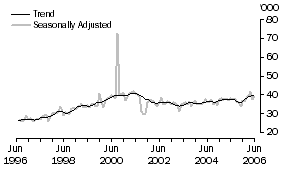 United Kingdom
United Kingdom
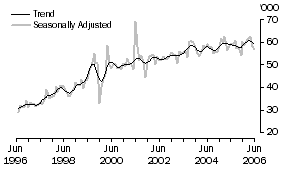 New Zealand
New Zealand
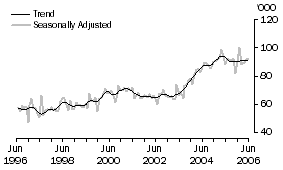
SHORT-TERM RESIDENT DEPARTURES
Selected destinations
For residents departing to the United States of America the graph illustrates the effect of the 11 September 2001 terrorist attacks in that country on short-term departures of Australian residents to the United States of America. The graph for New Zealand illustrates that the trend series for departures of Australian residents, which had experienced strong long-term growth, has plateaued since mid 2004. For Indonesia the graph shows the impact of the 12 October 2002 Bali bombing and the reduced level of travel experienced in the next twelve months. The effect of the 1 October 2005 Bali bombing is also evident and another break in the trend series was introduced.
United States of America
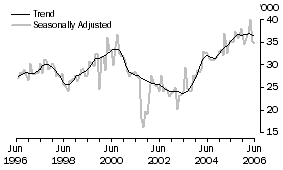 New Zealand
New Zealand
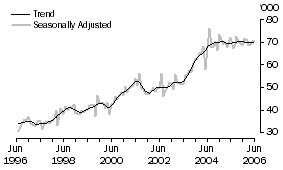 Indonesia
Indonesia
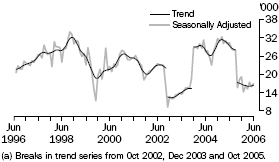
 Print Page
Print Page
 Print All
Print All